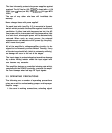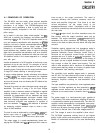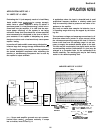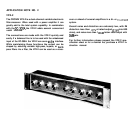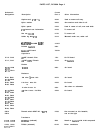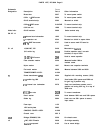
29
APPLICATION NOTE NO. 3
WARNING
POWER AMPLIFIER PROTECTION SYSTEMS PRO-
TECTAMPLIFIERS BUT NOT SPEAKERS! YOU, AND/
OR YOUR SPEAKER MANUFACTURER ARE RESPON-
SIBLE FOR SPEAKER PROTECTION!
Except in unusual sets of circumstances, the circuitry in-
cluded in power amplifiers designated as “protection”,
whether made up of transistor limiters, circuit breakers,
fuses, SCR’s, or whatever, is designed primarily to pro-
tect the amplifier from damage and will only protect
speakers incidentally. There are some exceptions to this
rule, which allow the user to vary the output power limits
of his amplifier to match the power rating of his speak-
ers Even this, however, is a far from perfect speaker
protection scheme. The reason why this holds true is
simple: each make or model speaker has its own unique
operating capabilities. As a rule, a speaker system (in-
cluding all electronics parts such as crossover parts and
electrostatic element transformers, as well as voice
coils) will be able to
drssipate
a certain amount of power
continuously without burning up. This depends on the size,
quality, configuration, etc., of those parts. The same
speaker will be able to handle a somewhat
hrgher
power
level for a short period of time (in the millisecond range)
without being destroyed by heat, but may then be endan-
gered by such phenomena as extending moving elements
beyond their normal range of travel (bottoming, torn dia-
phragm, etc.), overvoltaging electrostatic panels (arcing),
or other such suddenly disabling events. Since the points
at which these disastrous happenings will occur, differ for
different speakers, a speaker protection system must be
completely adjustable if it is to be useful for more than a
narrow range of speakers. Furthermore, if the user is to
be able to do adequate adjustment on a protection system
external to his speakers, he must receive accurate in-
formation about the speaker power handling capabilities
from the speaker manufacturer. Speaker protection sys-
tems embodied in amplifiers are comparatively useless,
therefore, unless the following things are true:
(1) The protection system can be accurately adjusted
by the user.
(2) The power handling capabilities of the speakers
are clearly stated by the manufacturer.
(3) The information about the speaker protection and
speaker power handling are stated in common
terms so that the user can adjust the protection
properly for the speaker.
These three things are rarely true simultaneously. It is
for this reason that CROWN takes the approach that
speaker protection is the responsibility of the speaker
manufacturer. Amplifier manufacturers have long been
required to provide protection in their products for any
faults
occuring
externally to the amplifier outputs, such
as speaker short circuits, open circuits, etc. In order to
fairly share the responsibility, and since the protection
cannot be exhaustively provided any other way, we feel
that speaker manufacturers should provide protection
tailored to their individual products. At CROWN we have
done this with our own speakers, simply because it is the
only comprehensive means of providing worthwhile pro-
tection for all of our speakers.
Increasing power available from modern amplifiers in-
creases the danger of speaker damage. Although occa-
sionally an internal amplifier malfunction can contribute
to speaker failure, it is much more likely that speakers
will be overpowered by inadvertant use of too much
power. In the absence of internal protection in most
speaker systems, CROWN recommends very strongly
that in-line speaker fuses be employed in all systems.
The fuse selection nomograph reprinted in each CROWN
amplifier manual can be an invaluable help in choosing
fuses of the proper size. However, the effectiveness of
fuses in protecting speakers is limited in two important
ways
(1) Fuses as a rule protect only against prolonged
overpowering, and can only prevent speakers from
being driven with more than their RMS or average
power rating. Fuses cannot protect against sudden
high level transients of short duration. The use of
high-speed instrument fuses will give the best pro-
tection available from fuses, but musical tran-
sients can have an effect before the fastest fuses
blow.
(2) An appropriate fuse can only be selected if the
manufacturer’s specifications for hrs speaker are
accurately and clearly stated. If a speaker can
handle 100 watt peaks and 30 watts continuously,
but is advertised, and therefore fused, as a 100
watt speaker, then the speaker will destroy itself
before the fuse can protect it under a continuous
power level above 30 watts.
There are more effective (also more complicated and ex-
pensive) methods of protecting speakers than fuses. Some
of these, including methods similar to those employed in
CROWN speakers, are illustrated in the load protection
section of CROWN amplifier manuals. But these systems,
as all others, must still be adjusted in accordance with
the power-handling capability of the speakers In use, and
this can still be most readily done by speaker manu-
facturers.
Your speakers have probably cost you at least as much
as any other part of your audio system. And since speak-
er sound continues to be the most subjective area of com-
ponent selection, you may also have devoted more time
and effort to selecting your speakers than you have de-
voted to any other part of your system. With these facts
in mind, be extremely careful in providing for adequate
protection of these often fragile, but most important, ex-
pressions of your audio taste.





